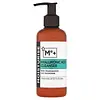What's inside
What's inside
 Key Ingredients
Key Ingredients

 Benefits
Benefits

 Concerns
Concerns

 Ingredients Side-by-side
Ingredients Side-by-side

Water
Skin ConditioningNiacinamide
SmoothingPentaerythrityl Tetraethylhexanoate
EmollientButylene Glycol
HumectantGlycerin
HumectantSqualane
EmollientTaraxacum Officinale Rhizome/Root Extract
Skin ConditioningSaccharomyces/Rice Ferment Filtrate
Skin ConditioningSodium Hydroxide
BufferingKaolin
AbrasiveAdenosine
Skin ConditioningCaprylyl Glycol
EmollientLactic Acid
BufferingPentylene Glycol
Skin ConditioningAcrylates/C10-30 Alkyl Acrylate Crosspolymer
Emulsion StabilisingSalicylic Acid
MaskingChlorphenesin
AntimicrobialParfum
MaskingWater, Niacinamide, Pentaerythrityl Tetraethylhexanoate, Butylene Glycol, Glycerin, Squalane, Taraxacum Officinale Rhizome/Root Extract, Saccharomyces/Rice Ferment Filtrate, Sodium Hydroxide, Kaolin, Adenosine, Caprylyl Glycol, Lactic Acid, Pentylene Glycol, Acrylates/C10-30 Alkyl Acrylate Crosspolymer, Salicylic Acid, Chlorphenesin, Parfum
Water
Skin ConditioningCetearyl Alcohol
EmollientGlycerin
HumectantCeteareth-20
CleansingCetyl Alcohol
EmollientNiacinamide
SmoothingPhenoxyethanol
PreservativeBehentrimonium Methosulfate
Xanthan Gum
EmulsifyingTetrasodium Glutamate Diacetate
Ethylhexylglycerin
Skin ConditioningSodium Hyaluronate Crosspolymer
HumectantCitric Acid
BufferingSodium Lauroyl Lactylate
EmulsifyingPentylene Glycol
Skin ConditioningSodium Hydroxide
BufferingCeramide NP
Skin ConditioningCholesterol
EmollientCeramide AP
Skin ConditioningPhytosphingosine
Skin ConditioningCarbomer
Emulsion StabilisingCeramide EOP
Skin ConditioningWater, Cetearyl Alcohol, Glycerin, Ceteareth-20, Cetyl Alcohol, Niacinamide, Phenoxyethanol, Behentrimonium Methosulfate, Xanthan Gum, Tetrasodium Glutamate Diacetate, Ethylhexylglycerin, Sodium Hyaluronate Crosspolymer, Citric Acid, Sodium Lauroyl Lactylate, Pentylene Glycol, Sodium Hydroxide, Ceramide NP, Cholesterol, Ceramide AP, Phytosphingosine, Carbomer, Ceramide EOP
 Reviews
Reviews

Ingredients Explained
These ingredients are found in both products.
Ingredients higher up in an ingredient list are typically present in a larger amount.
Glycerin is already naturally found in your skin. It helps moisturize and protect your skin.
A study from 2016 found glycerin to be more effective as a humectant than AHAs and hyaluronic acid.
As a humectant, it helps the skin stay hydrated by pulling moisture to your skin. The low molecular weight of glycerin allows it to pull moisture into the deeper layers of your skin.
Hydrated skin improves your skin barrier; Your skin barrier helps protect against irritants and bacteria.
Glycerin has also been found to have antimicrobial and antiviral properties. Due to these properties, glycerin is often used in wound and burn treatments.
In cosmetics, glycerin is usually derived from plants such as soybean or palm. However, it can also be sourced from animals, such as tallow or animal fat.
This ingredient is organic, colorless, odorless, and non-toxic.
Glycerin is the name for this ingredient in American English. British English uses Glycerol/Glycerine.
Learn more about GlycerinNiacinamide is a multitasking form of vitamin B3 that strengthens the skin barrier, reduces pores and dark spots, regulates oil, and improves signs of aging.
And the best part? It's gentle and well-tolerated by most skin types, including sensitive and reactive skin.
You might have heard of "niacin flush", or the reddening of skin that causes itchiness. Niacinamide has not been found to cause this.
In very rare cases, some individuals may not be able to tolerate niacinamide at all or experience an allergic reaction to it.
If you are experiencing flaking, irritation, and dryness with this ingredient, be sure to double check all your products as this ingredient can be found in all categories of skincare.
When incorporating niacinamide into your routine, look out for concentration amounts. Typically, 5% niacinamide provides benefits such as fading dark spots. However, if you have sensitive skin, it is better to begin with a smaller concentration.
When you apply niacinamide to your skin, your body converts it into nicotinamide adenine dinucleotide (NAD). NAD is an essential coenzyme that is already found in your cells as "fuel" and powers countless biological processes.
In your skin, NAD helps repair cell damage, produce new healthy cells, support collagen production, strengthen the skin barrier, and fight environmental stressors (like UV and pollution).
Our natural NAD levels start to decline with age, leading to slower skin repair, visible aging, and a weaker skin barrier. By providing your skin niacinamide, you're recharging your skin's NAD levels. This leads to stronger, healthier, and younger looking skin.
Another name for vitamin B3 is nicotinamide. This vitamin is water-soluble and our bodies don't store it. We obtain Vitamin B3 from either food or skincare. Meat, fish, wheat, yeast, and leafy greens contain vitamin B3.
The type of niacinamide used in skincare is synthetically created.
Learn more about NiacinamidePentylene glycol is typically used within a product to thicken it. It also adds a smooth, soft, and moisturizing feel to the product. It is naturally found in plants such as sugar beets.
The hydrophilic trait of Pentylene Glycol makes it a humectant. As a humectant, Pentylene Glycol helps draw moisture from the air to your skin. This can help keep your skin hydrated.
This property also makes Pentylene Glycol a great texture enhancer. It can also help thicken or stabilize a product.
Pentylene Glycol also acts as a mild preservative and helps to keep a product microbe-free.
Some people may experience mild eye and skin irritation from Pentylene Glycol. We always recommend speaking with a professional about using this ingredient in your routine.
Pentylene Glycol has a low molecular weight and is part of the 1,2-glycol family.
Learn more about Pentylene GlycolSodium Hydroxide is also known as lye or caustic soda. It is used to adjust the pH of products; many ingredients require a specific pH to be effective.
In small amounts, sodium hydroxide is considered safe to use. However, large amounts may cause chemical burns due to its high alkaline.
Your skin has a natural pH and acid mantle. This acid mantle helps prevent harmful bacteria from breaking through. The acid mantle also helps keep your skin hydrated.
"Alkaline" refers to a high pH level. A low pH level would be considered acidic.
Learn more about Sodium HydroxideWater. It's the most common cosmetic ingredient of all. You'll usually see it at the top of ingredient lists, meaning that it makes up the largest part of the product.
So why is it so popular? Water most often acts as a solvent - this means that it helps dissolve other ingredients into the formulation.
You'll also recognize water as that liquid we all need to stay alive. If you see this, drink a glass of water. Stay hydrated!
Learn more about Water